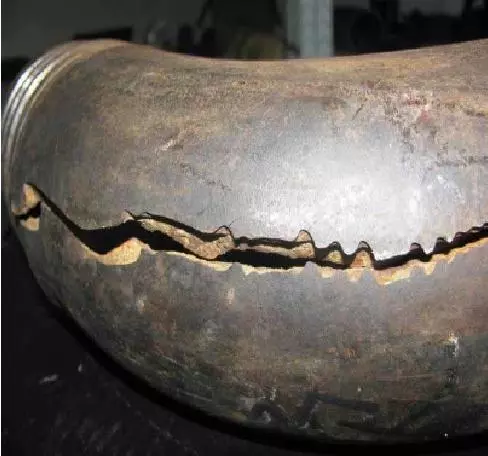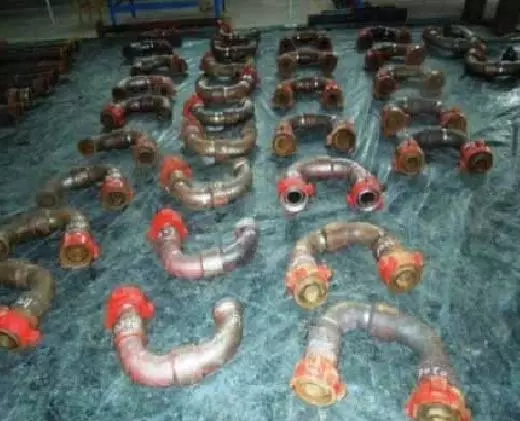A high-pressure pipe joint is also known as the high-pressure fluid control part. It is widely used in well cementation, fracturing and acidification testing, and wellhead equipment. Its working pressure is relatively high, generally ranging from tens of MPa to hundreds of MPa. There are many types of high-pressure pipe joints, and a bend is just one of them. However, bends account for the largest proportion of all pipe fittings used in high-pressure piping systems, about 80%. In the service process of high-pressure pipe joints, the interior needs to withstand high impact pressure and alternating loads, and the wear of thickness is great. The wear of the bend is especially more serious. Moreover, the fluids transported by the pipe joints are corrosive, so defects such as thinning of wall thickness, fatigue cracks and scouring are easy to occur and cause piercing or cracks, leading to the occurrence of major industrial accidents and causing great economic losses and casualties.
At present, with the development of technology, high-pressure pipe joints are widely used in all walks of life. High-pressure pipe joints are under high-pressure working conditions for a long time and the fluids conveyed are often corrosive, so the inner walls of high-pressure pipe joints often thin due to scouring. When the pipe's wall thickness is reduced to a certain extent, the high-pressure fluid in the high-pressure pipe joint will leak, such as piercing, bursting, etc. Pipelines are responsible for transporting various supplies, especially in petrochemical and other production. Once an accident occurs, it will endanger the normal production of the device, and may even cause vicious accidents such as fire, poisoning, and explosion. Therefore, in order to avoid accidents during on-site use, it is stipulated that high-pressure pipe joints, especially bends should be tested regularly. At present, traditional ultrasonic inspection and magnetic yoke inspection are mostly used. These two inspection methods are not only time-consuming and labor-intensive, but also have high requirements for inspectors. Inspectors must be professionally trained before they work. However, the new laser ultrasonic inspection saves manpower and has high efficiency and low requirements for inspection personnel. The research on the ultrasonic detection method of cracks of high-pressure bends is of great significance to the petrochemical industry.
At present, the detection of cracks is mainly non-destructive testing. In principle, and any method can be used to detect cracks in the pipe joint, such as penetration methods, ultrasonic methods, magnetic particle methods, radiation methods, eddy current methods, etc. However, different materials for pipe joints, wall thickness, and defective shapes make each detection method has certain limitations.
Conventional detection methods for cracks
The morphology of pipeline's cracks is complicated, and they are geometrically distributed, which have certain particularity. If the detection technology for corrosion is directly used to detect cracks, the result is not very ideal. The common cracks in petroleum industrial pipelines are generally divided into three types, namely stress corrosion cracking, hydrogen-induced cracking, and fatigue cracking. The distribution of these cracks is mainly in the longitudinal direction instead of the transverse direction. Once a crack occurs in the pipeline, the pressure of the fluid in the high-pressure pipe is very high, and the pipeline bears a great deal of pressure. Therefore, the crack is easy to rapidly expand and eventually cause the pipe wall to crack. The detection of cracks of pipelines is different from that of corrosion due to the geometric characteristics of the distribution of the pipeline's crack.
With the development of society and the improvement of people's living standards, the demand for clean energy is increasing. As a high-quality energy source, natural gas has obvious advantages in its cleanness, high efficiency, and environmental protection. The development of natural gas and improvement of the energy structure are the major trends in energy development at home and abroad. With the increase of oil and natural gas exploitation and application, pipeline transportation is gradually developing towards large diameters, great flow, and high pressure. A high-pressure bend is a kind of pipe fitting used for turning high-pressure pipelines. High-pressure bends are widely used in long-distance high-pressure pipelines and oilfield fracturing vehicles, especially during downhole fracturing in oilfields. The high-pressure bends need to withstand great pressure, the scouring of fracturing fluid, and tension and compression stress caused by circuitous pipe joints, which makes the high-pressure bend easily produce defects such as thinning of wall thickness, fatigue cracks, and scouring pits, and causes the high-pressure bend to pierce or rupture, as shown in Figure 1-1, leading to major industrial accidents and causing great economic losses and casualties.

Figure 1-1 The appearance of bursted bends
In order to avoid accidents, we have to conduct safety inspections on high-pressure bends on a regular basis. Taking the Western Downhole Quality Supervision and Inspection Center as an example, the high-pressure bends of the fracturing well team are sent for inspection once in May or June each year, and once again in December. This centralized inspection method makes the personnel in the inspection center have to work overtime. Even so, they still can not meet the production requirements for the fracturing well team. The fracturing well team has to stop working and wait for inspection results. Adopting traditional ultrasonic testing is unable to meet the production needs, which requires us to study new testing methods to solve this problem. The detection situation of pipe joints is shown in Figure 1-2.

Figure 1-2 The inspection site of pipe joints